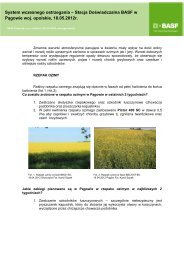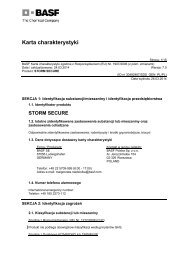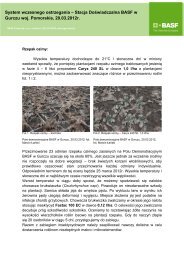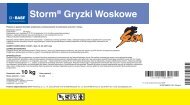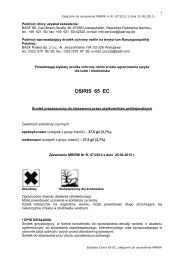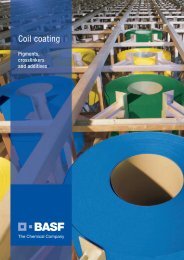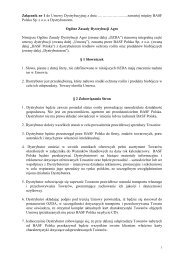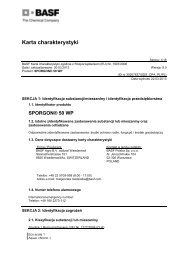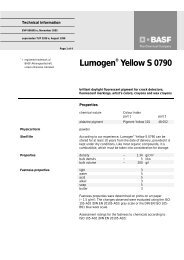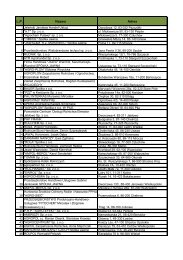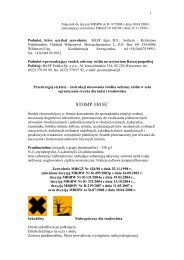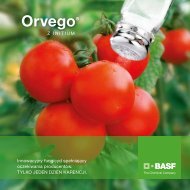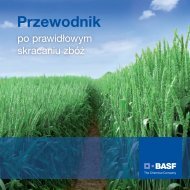Keep cool!
Keep cool!
Keep cool!
You also want an ePaper? Increase the reach of your titles
YUMPU automatically turns print PDFs into web optimized ePapers that Google loves.
<strong>Keep</strong> <strong>cool</strong>!<br />
Products for solar heat management in plastics
Cooler colors for solar heat<br />
management in plastics<br />
NIR-reflecting pigments for solar heat management in plastics<br />
Ultraviolet (UV, 295 – 400 nm)<br />
Recently, with energy prices rising and no end in sight, intelligent<br />
solutions for temperature management have moved into the focus<br />
of designers, architects and consumers. With this brochure, we<br />
would like to give an overview of BASF’s portfolio of pigments for<br />
the heat management of surfaces exposed to infrared radiation.<br />
The solar spectrum<br />
Light energy emitted by the sun spans a wide range of wavelengths.<br />
Part of the total energy is absorbed by our atmosphere<br />
and never reaches the earth's surface. The light that does get<br />
through is commonly classified into three ranges according to its<br />
wavelength. Generally, light with a shorter wavelength (or higher<br />
energy) than the visible range is referred to as ultraviolet (= beyond<br />
violet), while light with a longer wavelength (lower energy) than the<br />
visible range is referred to as infrared (= before red).<br />
The UV region starts at 295 nm where the atmosphere cut-off<br />
occurs and ends at 400 nm where we start to perceive the light<br />
as violet. Even though less than 5 % of the total solar energy<br />
reaching the earth is UV light, it is this part of the sunlight that<br />
causes degradation of polymers by breaking chemical bonds.<br />
UV light leads to phenomena such as chalking and the loss of<br />
mechanical properties of polymers and is also known to destroy<br />
colorants with inferior fastness to light as well as certain fillers.<br />
BASF offers a broad range of UV stabilizers for polymers, tailormade<br />
for the special demand of various polymers and various<br />
applications.<br />
Irradiant energy from the sun<br />
ultraviolet energy<br />
visible energy<br />
infrared (IR) energy<br />
C-C<br />
C C<br />
1<br />
1<br />
1<br />
C<br />
C<br />
C<br />
295 nm – 400 nm / 2.7 % of energy<br />
interaction with chemical bonds<br />
400 nm – 700 nm / 51.2 % of energy<br />
interaction with electrons<br />
700 nm – 2,500 nm / 46.1 % of energy<br />
interaction: vibration and/or rotation
W<br />
m 2 μm<br />
Visible (VIS, 400 – 700 nm)<br />
Infrared (IR, 700 – 2,500 nm)<br />
Roughly 50 % of the solar energy reaching the earth’s surface is<br />
“visible light”. The human eye translates different wavelengths<br />
(energy levels) into various colors. The interaction of this radiation<br />
with electrons in different energy levels of colored compounds<br />
determines the absorption and sometimes re-emission of light of<br />
different wavelengths. Combined with the scattering of light at solid<br />
particles’ surfaces, these phenomena define what we refer to as<br />
the color of an object. If an object reflects light across the complete<br />
wavelength range, then it appears white, black surfaces absorb all<br />
the energy at these wavelengths. If some wavelengths of this light<br />
are absorbed and others reflected, then an object appears to be<br />
colored. BASF offers organic and inorganic pigments for every color<br />
meeting the most stringent requirements with regard to fastness<br />
to light and weathering as well as long-term stability. Besides pigments,<br />
BASF also offers standard and fluorescent dyes which are<br />
soluble in the polymer matrix.<br />
Nearly 45 % of the sun’s energy is in the infrared (IR) range, with<br />
the major part in the near-IR range (NIR, 700 – 1,200 nm). NIR<br />
radiation interacts with chemical bonds, leading to stretching,<br />
bonding and rotating of molecules, finally increasing the material’s<br />
temperature. The higher the absorption in the infrared range, the<br />
higher the material’s temperature when exposed to solar radiation.<br />
The fact that infrared energy is emitted by all objects according to<br />
their surface temperature is utilized in, e.g., IR cameras. However,<br />
as the temperature of most objects is exceedingly low compared to<br />
the sun’s surface, this IR light is found at much longer wavelengths<br />
and the energy transferred is almost negligibly small.<br />
BASF offers pigments with optimized NIR absorbance as well as<br />
NIR-reflecting pigments for indoor and outdoor applications and<br />
<strong>cool</strong>er colors.<br />
Radiation at sea level<br />
2,500<br />
VIS<br />
NIR radiation<br />
2,000<br />
D e<br />
1,500<br />
1,000<br />
1<br />
2<br />
3<br />
500<br />
2<br />
2<br />
0<br />
0 0.25 0.5 0.75 1.0 1.25 1.5 1.75 2.0 2.25 2.5<br />
μm<br />
4 4<br />
black body radiation 5900 K 1 O 2<br />
extraterrestric sunlight, AM 0<br />
2 H 2<br />
O<br />
terrestric sunlight, AM 1.5<br />
3 O 2<br />
, H 2<br />
O<br />
4 H 2<br />
O, CO 2<br />
02 03
eflectance [%]<br />
NIR-reflecting pigments<br />
NIR Reflectance properties of Sicotan ® pigments<br />
100<br />
80<br />
60<br />
40<br />
20<br />
0<br />
400 600 800 1,000 1,200 1,400 1,600 1,800 2,000 2,200 2,400<br />
wavelength [nm]<br />
Ni-Sb-Ti Cr-Sb-Ti Mn-Sb-Ti<br />
Windows, garage doors, fences, roofing and siding<br />
NIR-reflecting pigments<br />
Rigid PVC is a temperature-sensitive product that degrades as it<br />
gets hotter. Vinyl siding, windows and door profiles will thus warp<br />
and twist out of shape if not manufactured with greatest care.<br />
Other polymers and rubbers used for outdoor applications such as<br />
fences, roofing tiles and balcony elements act similarly, because<br />
regular pigments used for coloration often considerably increase<br />
the tendency to warp by raising the temperature of the surface<br />
upon exposure to sunlight.<br />
BASF’s NIR-reflecting pigments offer an easy way of making colors,<br />
other than white, while reducing, if not eliminating, warping and<br />
twisting of the finished article in use.<br />
Both UV and IR light are invisible to the human eye and have no<br />
direct influence on the color of an object. However, all light, whether<br />
visible or invisible, will increase the temperature of an object<br />
when absorbed by it. The more solar energy the object absorbs, the<br />
greater the heat build-up. Conversely, the greater the reflectivity of<br />
an object, the lower its temperature when exposed to direct sunlight.<br />
Two objects can be identical in visible color, but have very different<br />
characteristics in the IR spectrum. An object that reflects IR light<br />
will remain <strong>cool</strong>er than an object that absorbs it.
Because IR light comprises 45 % of the incident solar energy,<br />
the IR reflectivity of an object is even slightly more important than<br />
its color when it comes to heat build-up.<br />
In addition to their reflective properties, pigments can differ in their<br />
weatherability, chemical resistance and other durability criteria.<br />
BASF offers a broad range of inorganic pigments with special<br />
performance in IR radiation. BASF's Sicotan ® pigments are based<br />
on titanium dioxide where selected atoms are incorporated in the<br />
crystal lattice of TiO 2 . The colors available cover the range from yellow<br />
(nickel incorporated, Pigment Yellow 53), beige and light brown<br />
(chromium incorporated, Pigment Brown 24) to dark and intense<br />
brown (manganese incorporated, Pigment Brown 164). Their fastness<br />
to light and weathering have been proven in more than three<br />
decades of exposure to the South Florida sun. Thus they are the<br />
pigments of choice for products that offer warranties against fading<br />
for 25 years or more.<br />
BASF's Sicopal ® pigments are hematite-structured metal oxides<br />
with intense brown and deep black colors (chrome-iron oxides,<br />
Pigment Brown 29), spinel-structured metal oxides with light brown<br />
colors (zinc oxide, Pigment Yellow 119) and blue and green shades<br />
(cobalt oxide, Pigment Blue 28 and Pigment Green 50) as well as<br />
intensely yellow bismuth vanadate (Pigment Yellow 184).<br />
04 05
Coextrusion<br />
Multi-layer structures<br />
Intense colors on top of a reflecting base<br />
In order to combine the excellent quality of NIR-reflecting pigments<br />
with intense colors in full shade, multi-layer systems are used, e.g.,<br />
formed by coextrusion. Not only do these organic pigments have to<br />
be transparent (non-absorbant for NIR light which most organic pigments<br />
are), but they must also offer outstanding fastness to light<br />
and weathering. To achieve the effects along with NIR-reflecting<br />
properties to increase the service life of the finished part, TiO 2 or<br />
NIR-reflecting pigments are used for the mass coloration of, e.g.,<br />
PVC as core material and organic pigments are used for the top<br />
layer of, e.g., PMMA or PC.<br />
This NIR-transparent top layer can contain the additives for UV<br />
protection of the complete system and the selected organic pigments<br />
for strong, intense colors.<br />
NIR light unhinderedly passes through the transparent layer, is<br />
reflected by the core material pigmented with TiO 2 - or NIR-reflecting<br />
pigments and again passes the transparent layer unhinderedly<br />
without absorption and consequently without heating the material.<br />
The part stays <strong>cool</strong>.<br />
Multi-layer profiles<br />
NIR-transparent<br />
colored topcoat<br />
NIR-reflecting pigment<br />
opaque substrate, pigmented with NIR-reflecting pigments<br />
(e.g., PVC window profile with TiO 2 , Sicotan ® Yellow or Brown)
eflectance [%]<br />
Reflectance of typical organic pigments<br />
100<br />
80<br />
60<br />
40<br />
20<br />
0<br />
400 600 800 1,000 1,200 1,400 1,600 1,800 2,000 2,200 2,400 2,600<br />
wavelength [nm]<br />
yellow pigment red pigment purple pigment<br />
Measured in PVC in front of a reflecting white standard<br />
06 07
Lumogen ® Black –<br />
a black that stays <strong>cool</strong><br />
Transparent black – the missing link in coextrusion<br />
As many organic pigments are transparent for NIR light, a wide<br />
range of colors is possible using the coextrusion method. But if darker<br />
shades are looked for, until now, basically the only option for<br />
long-term stable shading has been carbon black. However, Carbon<br />
black as a highly efficient broadband absorber absorbs the complete<br />
range of wavelengths of incident sunlight at the earth’s surface,<br />
including UV and IR. This is why our experience tells us that in<br />
summer a black surface is also a hot surface. Even at very low<br />
concentrations, carbon black can thus decisively change the solar<br />
heat absorption behavior of a surface.<br />
NIR-reflecting black pigments have been available for some time<br />
now, but all of them are designed for the mass coloration of the<br />
opaque core, not for the transparent top coat. For these highperformance<br />
applications, BASF now offers two new black pigments,<br />
which offer superb temperature stability, excellent fastness<br />
to light and fastness to weathering and high color strength while<br />
exhibiting outstanding transparency in the NIR range.<br />
Lumogen ® Black FK 4280 and Lumogen ® Black FK 4281 make it<br />
possible not only to generate <strong>cool</strong> black, but also to create dark<br />
shades of other colors as well as all shades of <strong>cool</strong> grays for many<br />
different polymers including polyolefins, PMMA, SAN, PA and PVC,<br />
even PVC-p.<br />
Fastness to weathering and fastness to light in different polymers after 2000 h<br />
Fastness to weathering<br />
Fastness to light<br />
Lumogen ® Black Lumogen ® Black Lumogen ® Black Lumogen ® Black<br />
FK 4280 FK 4281 FK 4280 FK 4281<br />
PMMA Plexiglas ®1 7 N 5 5 8 8<br />
SAN Luran ® 378 P 5 5 8 8<br />
PA Ultramid ® B 3 S 5 5 8 8<br />
five-step-scale: 5 = best value<br />
eight-step-scale: 8 = best value
transmission [%]<br />
Transmission properties of Lumogen ® and carbon black<br />
100<br />
90<br />
80<br />
70<br />
60<br />
50<br />
40<br />
30<br />
20<br />
10<br />
0<br />
UV visible NIR<br />
300 500 700 900 1,100 1,300<br />
wavelength [nm]<br />
Lumogen ® Black FK 4280<br />
Lumogen ® Black FK 4281<br />
carbon black<br />
08 09
eflectance [%]<br />
reflectance [%]<br />
reflectance [%]<br />
transmission<br />
transmission<br />
transmission<br />
Sicotan ® Yellow and<br />
Sicotan ® Brown<br />
Sicotan ® Yellow K 1010 FG / 2.0 % in PVC-u<br />
Sicotan ® Yellow K 1010 FG / 2.0 % in PVC-u<br />
100<br />
100<br />
80<br />
80<br />
60<br />
PVC<br />
PVC<br />
60<br />
40<br />
40<br />
20<br />
PVC<br />
20<br />
0<br />
400 600 800 1,000 1,200 1,400 1,600 1,800 2,000 2,200 2,400<br />
wavelength [nm]<br />
0<br />
400 600 800 1,000 1,200 1,400 1,600 1,800 2,000 2,200 2,400<br />
wavelength [nm]<br />
PVC<br />
100<br />
Sicotan ® Yellow K 2001 FG / 1.0 % in PVC-u<br />
100<br />
Sicotan ® Yellow K 2001 FG / 1.0 % in PVC-u<br />
80<br />
80<br />
60<br />
PVC<br />
PVC<br />
60<br />
40<br />
40<br />
20<br />
PVC<br />
20<br />
PVC<br />
0<br />
400 600 800 1,000 1,200 1,400 1,600 1,800 2,000 2,200 2,400<br />
wavelength [nm]<br />
0<br />
400 600 800 1,000 1,200 1,400 1,600 1,800 2,000 2,200 2,400<br />
wavelength [nm]<br />
100<br />
Sicotan ® Brown K 2611 / 1.0 % in PVC-u<br />
100<br />
Sicotan ® Brown K 2611 / 1.0 % in PVC-u<br />
80<br />
80<br />
60<br />
PVC<br />
PVC<br />
60<br />
40<br />
40<br />
20<br />
PVC<br />
20<br />
PVC<br />
0<br />
400 600 800 1,000 1,200 1,400 1,600 1,800 2,000 2,200 2,400<br />
wavelength [nm]<br />
0<br />
400 600 800 1,000 1,200 1,400 1,600 1,800 2,000 2,200 2,400<br />
wavelength [nm]<br />
all reflectance data determined on PVC in front of a white reflecting standard
Sicotan ® Yellow K 1010 FG<br />
1:4<br />
Sicotan ® Yellow K 1010 and Yellow K 1011 are rutile-structured<br />
pigments in yellow shades (Pigment Yellow 53), available in powder<br />
form and as fine granules (FG).<br />
Sicotan ® pigments have excellent fastness to light, fastness to<br />
weathering and stability against chemicals; their high heat stability<br />
makes them suitable in most resins even in extreme reductions.<br />
Sicotan ® Yellow K 1010 FG<br />
2.0 %<br />
Sicotan ® pigments are suitable for use in blends with organic<br />
pigments for brilliant shades with high opacity.<br />
The high reflectance ratio for NIR light makes the Sicotan ® pigments<br />
the ideal pigments for outdoor application which offer warranties<br />
against fading for lots of years.<br />
Sicotan ® Yellow K 2001 FG<br />
1:4<br />
Sicotan ® Yellow K 2001, Yellow K 2007 and Yellow K 2011 are<br />
pigments of light beige color, Sicotan ® Yellow K 2111 and Yellow<br />
K 2112 are light brown and more reddish (all are Pigment Brown 24).<br />
They are available both in powder form and as fine granules (FG).<br />
Sicotan ® pigments have excellent fastness to light, fastness to<br />
weathering and stability against chemicals; their high heat stability<br />
makes them suitable in most resins even in extreme reductions.<br />
Sicotan ® Yellow K 2001 FG<br />
1.0 %<br />
Sicotan ® pigments are suitable for use in blends with organic<br />
pigments for brilliant shades with high opacity.<br />
The high reflectance ratio for NIR light makes the Sicotan ® pigments<br />
the ideal pigments for outdoor application which offer warranties<br />
against fading for many years, especially for window profiles and<br />
sidings applications.<br />
Sicotan ® Brown K 2611<br />
1:4<br />
Sicotan ® Brown K 2611 and Brown K 2711 are pigments in brown<br />
shades (Pigment Brown 164), available in powder form.<br />
Sicotan ® pigments have excellent fastness to light, fastness to<br />
weathering and stability against chemicals; their high heat stability<br />
makes them suitable in most resins even in extreme reductions.<br />
Sicotan ® Brown K 2611<br />
1.0 %<br />
The high reflectance ratio for NIR light makes the Sicotan ® pigments<br />
the ideal pigments for outdoor application which offer warranties<br />
against fading for many years, especially in brown PVC profiles<br />
(free from Fe ions) and in reddish gray shades at high tinting rates<br />
in sidings and roofing.<br />
10 11
eflectance [%]<br />
reflectance [%]<br />
reflectance [%]<br />
transmission<br />
transmission<br />
transmission<br />
Sicopal ® Brown and<br />
Sicotrans ® Red<br />
Sicopal ® Brown K 2595 / 0.5 % in PVC-u<br />
Sicopal ® Brown K 2595 / 0.5 % in PVC-u<br />
100<br />
100<br />
80<br />
80<br />
60<br />
PVC<br />
PVC<br />
60<br />
PVC<br />
PVC<br />
40<br />
40<br />
PVC<br />
20<br />
PVC<br />
20<br />
0<br />
400 600 800 1,000 1,200 1,400 1,600 1,800 2,000 2,200 2,400<br />
wavelength [nm]<br />
0<br />
400 600 800 1,000 1,200 1,400 1,600 1,800 2,000 2,200 2,400<br />
wavelength [nm]<br />
100<br />
Sicopal ® Brown K 2795 FG / 0.5 % in PVC-u<br />
100<br />
Sicopal ® Brown K 2795 FG / 0.5 % in PVC-u<br />
80<br />
80<br />
60<br />
PVC<br />
PVC<br />
60<br />
PVC<br />
PVC<br />
40<br />
40<br />
PVC<br />
20<br />
PVC<br />
20<br />
0<br />
400 600 800 1,000 1,200 1,400 1,600 1,800 2,000 2,200 2,400<br />
wavelength [nm]<br />
0<br />
400 600 800 1,000 1,200 1,400 1,600 1,800 2,000 2,200 2,400<br />
wavelength [nm]<br />
100<br />
Sicotrans ® Red K 2915 / 0.5 % in PVC-u<br />
100<br />
Sicotrans ® Red K 2915 / 0.5 % in PVC-u<br />
80<br />
60<br />
PVC<br />
PVC<br />
80<br />
60<br />
PVC<br />
PVC<br />
PVC<br />
40<br />
40<br />
20<br />
PVC<br />
20<br />
0<br />
400 600 800 1,000 1,200 1,400 1,600 1,800 2,000 2,200 2,400<br />
wavelength [nm]<br />
0<br />
400 600 800 1,000 1,200 1,400 1,600 1,800 2,000 2,200 2,400<br />
wavelength [nm]<br />
all reflectance data determined on PVC in front of a white reflecting standard
Sicopal ® Brown K 2595<br />
1:4<br />
Sicopal ® Brown K 2595<br />
0.5 %<br />
Sicopal ® Brown K 2595 is a spinel-structured metal oxide of<br />
medium brown color (Pigment Brown 119). The very good heat<br />
resistance makes it suitable for the coloration of nearly all plastics,<br />
Sicopal ® Brown K 2595 causes no warpage in injection-molded or<br />
extruded parts – not even large ones.<br />
Sicopal ® Brown K 2595 is outstandingly fast to weathering in<br />
outdoor applications. Due to the many established PVC stabilization<br />
systems based on calcium/zinc or certain tin compounds, we<br />
recommend suitability tests under customer-specific processing<br />
parameters for PVC-u and PVC-p.<br />
Sicopal ® Brown K 2795 FG<br />
1:4<br />
Sicopal ® Brown K 2795 FG<br />
0.5 %<br />
Sicopal ® Brown K 2795 is a hematite-structured metal oxide of<br />
intense dark brown color (Pigment Brown 29). The very good heat<br />
resistance makes it suitable for the coloration of nearly all plastics,<br />
Sicopal ® Brown K 2795 causes no warpage in injection-molded or<br />
extruded parts – not even large ones.<br />
Sicopal ® Brown K 2795 is outstandingly fast to weathering in<br />
outdoor applications. Due to the many established PVC stabilization<br />
systems based on calcium/zinc or certain tin compounds, we<br />
recommend suitability tests under customer-specific processing<br />
parameters for PVC.<br />
Sicotrans ® Red K 2915<br />
1:4<br />
Sicotrans ® Red K 2915 is a semi-transparent, Sicotrans ® Red K 2819<br />
a transparent iron oxide, both are iron oxide (Pigment Red 101) with<br />
an extremely small particle size.<br />
Sicotrans ® Red K 2819 yields highly transparent colorations with<br />
UV-absorbing properties. Sicotrans ® Red K 2915 allows semitransparent<br />
full-shade colorations with high chroma to be achieved.<br />
Sicotrans ® Red K 2915<br />
0.5 %<br />
Iron ions can cause degradation especially in some PVC<br />
applications, so we recommend suitability tests under customerspecific<br />
processing parameters.<br />
The outstanding transparency of these pigments is particularly<br />
advantageous in the coloration of polyolefin fibers or polymers<br />
for bottles.<br />
12 13
eflectance [%]<br />
reflectance [%]<br />
reflectance [%]<br />
transmission<br />
transmission<br />
transmission<br />
Sicopal ® Yellow, Sicopal ® Blue<br />
and Sicopal ® Green<br />
Sicopal ® Yellow K 1160 FG / 1.0 % in PVC-u<br />
Sicopal ® Yellow K 1160 FG / 1.0 % in PVC-u<br />
100<br />
100<br />
80<br />
80<br />
PVC<br />
PVC<br />
60<br />
60<br />
PVC<br />
PVC<br />
40<br />
40<br />
PVC<br />
20<br />
PVC<br />
20<br />
0<br />
400 600 800 1,000 1,200 1,400 1,600 1,800 2,000 2,200 2,400<br />
wavelength [nm]<br />
0<br />
400 600 800 1,000 1,200 1,400 1,600 1,800 2,000 2,200 2,400<br />
wavelength [nm]<br />
100<br />
Sicopal ® Blue K 6310 / 1.0 % in PVC-u<br />
100<br />
Sicopal ® Blue K 6310 / 1.0 % in PVC-u<br />
80<br />
80<br />
60<br />
60<br />
PVC<br />
40<br />
40<br />
20<br />
PVC<br />
PVC<br />
PVC<br />
20<br />
0<br />
400 600 800 1,000 1,200 1,400 1,600 1,800 2,000 2,200 2,400<br />
wavelength [nm]<br />
0<br />
400 600 800 1,000 1,200 1,400 1,600 1,800 2,000 2,200 2,400<br />
wavelength [nm]<br />
100<br />
Sicopal ® Green K 9710 / 1.0 % in PVC-u<br />
100<br />
Sicopal ® Green K 9710 / 1.0 % in PVC-u<br />
80<br />
80<br />
60<br />
60<br />
40<br />
40<br />
20<br />
PVC<br />
20<br />
PVC<br />
0<br />
400 600 800 1,000 1,200 1,400 1,600 1,800 2,000 2,200 2,400<br />
wavelength [nm]<br />
0<br />
400 600 800 1,000 1,200 1,400 1,600 1,800 2,000 2,200 2,400<br />
wavelength [nm]<br />
all reflectance data determined on PVC in front of a white reflecting standard
Sicopal ® Yellow K 1160 FG<br />
1:4<br />
Sicopal ® Yellow K 1160 FG and Sicopal ® K 1120 FG are low-dusting<br />
fine-granule bismuth vanadate pigments (C.I. 184).<br />
The heat resistance of Sicopal ® Yellow K 1160 FG is excellent: 260 –<br />
280 °C (500 – 536 °F) in polyolefins and ABS as well as 280 – 300 °C<br />
(536 – 572 °F) in PA.<br />
Sicopal ® Yellow K 1120 FG is especially designed for polyolefins.<br />
Sicopal ® Yellow K 1160 FG<br />
1.0 %<br />
Their outstanding fastness to weathering makes them particularly suitable<br />
for outdoor applications (garden furniture, garbage cans)<br />
as a substitute to lead- or cadmium-based pigments.<br />
Both bismuth vanadate pigments can show low alkaline stability in<br />
some applications.<br />
Sicopal ® Blue K 6310<br />
1:4<br />
Sicopal ® Blue K 6310<br />
1.0 %<br />
Sicopal ® Blue K 6210, Blue K 6310, Blue K 7210 and Blue K 7310 are<br />
spinel-structured metal oxides with transparent intense blue shades<br />
(Pigment Blue 28).<br />
Their very good heat resistance makes them suitable for the<br />
coloration of nearly all plastics. Sicopal ® pigments do not cause<br />
warpage in injection-molded or extruded parts – not even large<br />
ones. This and their outstanding fastness to weathering make them<br />
perfectly suitable for special applications such as, e.g., bottle crates.<br />
Sicopal ® Green K 9710<br />
1:4<br />
Sicopal ® Green K 9710 is a spinel-structured metal oxide with a dark<br />
green color (Pigment Green 50).<br />
Their very good heat resistance makes them suitable for the<br />
coloration of nearly all plastics. Sicopal ® pigments do not cause<br />
warpage in injection-molded or extruded parts – not even large<br />
ones. This and their outstanding fastness to weathering make them<br />
perfectly suitable for special applications in technical polymers.<br />
Sicopal ® Green K 9710<br />
1.0 %<br />
14 15
Contact worldwide<br />
Asia<br />
BASF East Asia Regional Headquarters Ltd.<br />
45/F, Jardine House<br />
No. 1 Connaught Place<br />
Central<br />
Hong Kong<br />
Tel.: +852 2731 4312<br />
Fax: +852 2734 9670<br />
Europe<br />
BASF Aktiengesellschaft<br />
Performance Chemicals for<br />
Coatings, Plastics and Specialties<br />
E-EVP/EP – J 550<br />
67056 Ludwigshafen<br />
Germany<br />
Tel.: +49 621 60-72736<br />
Fax: +49 621 60-58320<br />
Eastern Europe, Africa, West Asia<br />
BASF Aktiengesellschaft<br />
Regional Business Management<br />
Performance Chemicals<br />
EUM/SE – Benckiserplatz 1<br />
67056 Ludwigshafen<br />
Germany<br />
Tel.: +49 621 60-76246<br />
Fax: +49 621 60-6676246<br />
South America<br />
BASF S.A.<br />
Estrada Samuel Aizemberg<br />
1707-Bloco C-3°<br />
09851-550 São Bernardo do Campo – SP<br />
Brazil<br />
Tel.: +55 11 4343-3637<br />
Fax: +55 11 4343-2040<br />
North America<br />
BASF Corporation<br />
100 Campus Drive<br />
Florham Park, NJ 07932<br />
USA<br />
Tel.: +1-973-245-6131<br />
Fax: +1-973-245-6733<br />
The data contained in this publication are based on our current knowledge and experience. In view of<br />
the many factors that may affect processing and application of our product, these data do not relieve<br />
processors from carrying out their own investigations and tests; neither do these data imply any guarantee<br />
of certain properties, nor the suitability of the product for a specific purpose. Any descriptions,<br />
drawings, photographs, data, proportions, weights etc. given herein may change without prior information<br />
and do not constitute the agreed contractual quality of the product. It is the responsibility of the<br />
recipient of our products to ensure that any proprietary rights and existing laws and legislation are<br />
observed. When handling these products, advice and information given in the safety data sheet must be<br />
complied with. Further, protective and workplace hygiene measures adequate for handling chemicals<br />
must be observed.<br />
® = registered trademark of BASF Aktiengesellschaft<br />
®1 = registered trademark of Röhm GmbH & Co. KG<br />
www.basf.com/pigment<br />
BASF Aktiengesellschaft<br />
Performance Chemicals for<br />
Coatings, Plastics and Specialties<br />
67056 Ludwigshafen<br />
Germany<br />
EVP 2506 e



